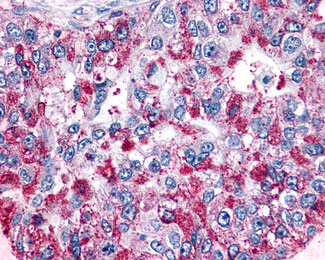GPR4 Antibody (C-Terminus)
Rabbit Polyclonal Antibody
- SPECIFICATION
- CITATIONS
- PROTOCOLS
- BACKGROUND

Application
| IHC-P, ICC |
|---|---|
| Primary Accession | P46093 |
| Reactivity | Human, Monkey, Dog |
| Host | Rabbit |
| Clonality | Polyclonal |
| Calculated MW | 41kDa |
| Dilution | IHC-P (24 µg/ml) |
| Gene ID | 2828 |
|---|---|
| Other Names | G-protein coupled receptor 4, G-protein coupled receptor 19, GPR4, GPR19 |
| Target/Specificity | Human GPR4. BLAST analysis of the peptide immunogen showed no homology with other human proteins. |
| Reconstitution & Storage | Long term: -70°C; Short term: +4°C |
| Precautions | GPR4 Antibody (C-Terminus) is for research use only and not for use in diagnostic or therapeutic procedures. |
| Name | GPR4 {ECO:0000303|PubMed:7832990, ECO:0000312|HGNC:HGNC:4497} |
|---|---|
| Function | Proton-sensing G-protein coupled receptor activated by extracellular pH, which is required to monitor pH changes and generate adaptive reactions (PubMed:12955148, PubMed:17462861, PubMed:33478938, PubMed:39753132, PubMed:39799123). Activated by an optimal pH of 6.8- 7.2 (PubMed:12955148, PubMed:17462861, PubMed:39753132). Ligand binding causes a conformation change that triggers signaling via guanine nucleotide-binding proteins (G proteins) and modulates the activity of downstream effectors, such as adenylate cyclase (PubMed:39753132). GPR4 is mainly coupled to G(s) G proteins and mediates activation of adenylate cyclase activity (PubMed:12955148, PubMed:17462861, PubMed:20211729, PubMed:22110680, PubMed:39753132). May also couple with G(q) and G(12)/G(13) G proteins (PubMed:12955148, PubMed:17462861, PubMed:20211729, PubMed:22110680). Acts as a key regulator of respiratory sensitivity to CO2/H(+) in brain retrotrapezoid nucleus neurons: acts by mediating detection of protons generated by the formation of carbonic acid in the blood, an important mechanism to impulse to breathe (By similarity). Also acts as a regulator of acid secretion in the kidney collecting duct by maintaining acid-base homeostasis in the kidney (By similarity). Acidosis-induced GPR4 activation increases paracellular gap formation and permeability of vascular endothelial cells, possibly through the G(12)/G(13)/Rho GTPase signaling pathway (PubMed:32058960). |
| Cellular Location | Cell membrane; Multi-pass membrane protein |
| Volume | 50 µl |

Thousands of laboratories across the world have published research that depended on the performance of antibodies from Abcepta to advance their research. Check out links to articles that cite our products in major peer-reviewed journals, organized by research category.
info@abcepta.com, and receive a free "I Love Antibodies" mug.
Provided below are standard protocols that you may find useful for product applications.
Background
Proton-sensing receptor coupled to several G-proteins, including G(s), G(13) and G(q)/G(11) proteins, leading to cAMP production.
References
Heiber M.,et al.DNA Cell Biol. 14:25-35(1995).
Mahadevan M.S.,et al.Genomics 30:84-88(1995).
An S.,et al.FEBS Lett. 375:121-124(1995).
Kaighin V.A.,et al.Submitted (DEC-2007) to the EMBL/GenBank/DDBJ databases.
Ota T.,et al.Nat. Genet. 36:40-45(2004).
If you have used an Abcepta product and would like to share how it has performed, please click on the "Submit Review" button and provide the requested information. Our staff will examine and post your review and contact you if needed.
If you have any additional inquiries please email technical services at tech@abcepta.com.













 Foundational characteristics of cancer include proliferation, angiogenesis, migration, evasion of apoptosis, and cellular immortality. Find key markers for these cellular processes and antibodies to detect them.
Foundational characteristics of cancer include proliferation, angiogenesis, migration, evasion of apoptosis, and cellular immortality. Find key markers for these cellular processes and antibodies to detect them. The SUMOplot™ Analysis Program predicts and scores sumoylation sites in your protein. SUMOylation is a post-translational modification involved in various cellular processes, such as nuclear-cytosolic transport, transcriptional regulation, apoptosis, protein stability, response to stress, and progression through the cell cycle.
The SUMOplot™ Analysis Program predicts and scores sumoylation sites in your protein. SUMOylation is a post-translational modification involved in various cellular processes, such as nuclear-cytosolic transport, transcriptional regulation, apoptosis, protein stability, response to stress, and progression through the cell cycle. The Autophagy Receptor Motif Plotter predicts and scores autophagy receptor binding sites in your protein. Identifying proteins connected to this pathway is critical to understanding the role of autophagy in physiological as well as pathological processes such as development, differentiation, neurodegenerative diseases, stress, infection, and cancer.
The Autophagy Receptor Motif Plotter predicts and scores autophagy receptor binding sites in your protein. Identifying proteins connected to this pathway is critical to understanding the role of autophagy in physiological as well as pathological processes such as development, differentiation, neurodegenerative diseases, stress, infection, and cancer.


